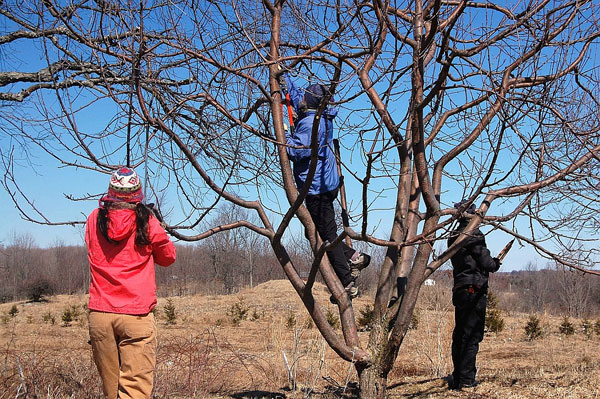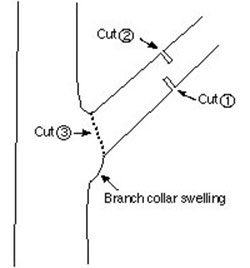Pruning season: Trees and threes

It’s time to prune the apple trees at the Van de Water farm in Canton. Archive Photo of the Day: Carol Kepes.
As far as trees are concerned, right now is the optimal time for pruning. And given that early spring is usually a pretty enjoyable time to be outdoors, you may tend to concur. Tree pruning is best done in the dormant season (or in late summer—more on that below), but during the four to six weeks leading up to bud-break, tree defense systems are perking up even though they have nothing to show for it on the outside. It’s sort of the best of two worlds: Trees’ growth processes remain in deep slumber, but their shields are up against infection. Plus it’s a lot nicer working outdoors now than in January or February. OK, I guess that’s three worlds.
Actually, there are a lot of threes involved in proper pruning. For example, no more than a third of a tree’s live branches should be removed during any pruning cycle. Older trees, however, and those under a lot of stress, need a lighter touch. Twenty percent is maximum for them. This doesn’t mean you can remove a third of the leaf-bearing material each year. A typical pruning cycle for a shade tree is (surprise) three years.
Another guideline is that two-thirds of a tree’s leaf area should be in the lower half of the crown. In other words, don’t clean out interior foliage or remove lower branches unless there is a compelling reason to do so, such as safety or disease management. Lower and interior branches are essential.
It seems counter-intuitive, but on hot summer days, leaves in the upper canopy actually get too much sun to work. Above about 85 degrees, they become so hot they are no longer able to photosynthesize. But the shaded lower branches are able to still carry on essential tree business until things cool down for the leaves up top. Hence the two-thirds rule.
Getting started means looking for the three Ds: dead, damaged, and diseased branches. They get the ax first. Once the three Ds are out of the way it’s easier to see what else needs attention. If you find crossing and/or rubbing branches, take the less desirable of the two. Whenever possible, favor wide branch-to-trunk attachments over narrow ones, which are more prone to breakage.
In most cases, a branch is pruned back to the main trunk. But sometimes pruning back a large limb to a side branch is preferred for aesthetic reasons. When doing so, make sure that the side branch is at least one-third the diameter of the branch you cut off.

3-stage cut for large branches. Don’t cut branches flush. Leave the branch collar swelling. Drawing: University of Minnesota Extension
“Prune the branch, not the trunk.” This statement, ridiculous on its face, is important. At the base of most branches is a swollen area called a branch collar, which produces fungicides (seriously), and also closes wounds more rapidly than ordinary trunk tissue can. The branch collar is part of the trunk and should never be cut. To put it simply, flush cuts are bad.
If a branch is more than an inch in diameter, there is a greater risk of having a strip of bark tear down the trunk, especially in early spring when the bark peels readily. Using a 3-stage cut will eliminate or greatly reduce this problem. First, make a cut on the underside of the branch about one-third of the way through, a foot away from the trunk. Cut #2 is made directly above the first. Once the branch is removed, grasp the stub and carefully make the third cut just outside the branch collar.
Obviously, maples “bleed” if pruned in March or April. While research tells us the loss of sugars is not significant, you may want to prune maple and butternut trees in mid- to late July, which is the second-best time to prune trees in terms of their health. For fruit trees which tend to water-sprout excessively, a late-summer pruning will greatly reduce this problem. Be sure to park your saw, though, during spring leaf-out and again in the fall before leaf drop—pruning in these times can lead to serious long-term problems. For trees, mostly.
The right tools make all the difference. If you had to shovel your driveway with a spatula, you’d soon despair. And you can imagine that changing a tire using only a pair of pliers would be miserable. A high-quality hand saw and bypass-type hand pruners are essential for pruning, and a good lopper is a welcome bonus. Pruning with cheap tools is agony. But good tools will last a lifetime and you’ll be amazed at the difference they make. You’ll probably have to order online—just search for “arborist pruning tools.”
In the past, pruning cuts were painted with various wound-dressing compounds, but research has shown that coating a tree wound can actually accelerate decay. To the best of my knowledge, though, people-wounds can still be covered up with Band-Aids. Keep one on hand, because good pruning tools are really sharp. Or maybe you should have three of them, just in case.
Paul Hetzler is a horticulture and natural resources educator with Cornell Cooperative Extension of St. Lawrence County.







